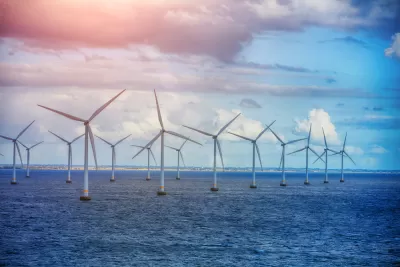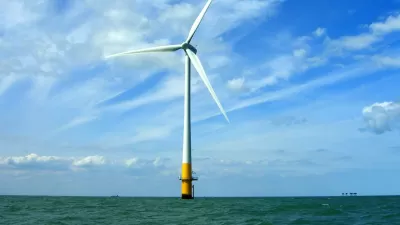If approved, the plan to build a 2,000-megawatt facility off the coast of Washington State would be a milestone for floating offshore wind production in the United States.

A proposed offshore wind project in Washington state would be the largest of its kind on the West Coast, reports David Iaconangelo. “The proposal could include up to 2,000 megawatts of electricity, enough for about 800,000 homes, produced from turbines mounted on platforms and moored to the deep ocean floor about 43 miles off the coast of Grays Harbor County, Wash.”
The proposal, like other offshore wind plans, will likely face criticism from environmental groups, the fishing industry, and local tribes. “Yet it underscores the growing expectations around a new, floating generation of offshore wind turbines, which have never been built in the United States, even at pilot scale.” According to Iaconangelo, “[Bureau of Ocean Energy Management (BOEM)] spokespeople told E&E News that the agency is reviewing the plan and will work with tribes, the state of Washington and others on the next steps.”
“By 2030, Washington state’s utilities are required to get at least 80 percent of their electricity from carbon-free resources, followed by 100 percent in 2045, under the terms of a 2019 law.” But the state has been moving more slowly than others, the article notes. “State governors have been major influences in the development of offshore wind on the East Coast by pledging to buy power from the resource. Washington state has no such commitment to purchase offshore wind power as of yet.” Other concerns include a potentially outdated electric grid and the higher cost of floating offshore wind as compared to fixed-bottom or on-shore wind production.
FULL STORY: Company proposes largest offshore wind farm on West Coast

Study: Maui’s Plan to Convert Vacation Rentals to Long-Term Housing Could Cause Nearly $1 Billion Economic Loss
The plan would reduce visitor accommodation by 25,% resulting in 1,900 jobs lost.

North Texas Transit Leaders Tout Benefits of TOD for Growing Region
At a summit focused on transit-oriented development, policymakers discussed how North Texas’ expanded light rail system can serve as a tool for economic growth.

Why Should We Subsidize Public Transportation?
Many public transit agencies face financial stress due to rising costs, declining fare revenue, and declining subsidies. Transit advocates must provide a strong business case for increasing public transit funding.

Dear Tesla Driver: “It’s not You, It’s Him.”
Amidst a booming bumper sticker industry, one writer offers solace to those asking, “Does this car make me look fascist?”

A Visual Celebration of Manhattan’s Chinatown Elder Community, Through Food
Lanterns, cafeteria trays, and community connection take center stage in this stunning photo essay.

How to Make US Trains Faster
Changes to boarding platforms and a switch to electric trains could improve U.S. passenger rail service without the added cost of high-speed rail.
Urban Design for Planners 1: Software Tools
This six-course series explores essential urban design concepts using open source software and equips planners with the tools they need to participate fully in the urban design process.
Planning for Universal Design
Learn the tools for implementing Universal Design in planning regulations.
City of Santa Clarita
Ascent Environmental
Institute for Housing and Urban Development Studies (IHS)
City of Grandview
Harvard GSD Executive Education
Toledo-Lucas County Plan Commissions
Salt Lake City
NYU Wagner Graduate School of Public Service




























